Nursing Communication Skills: Documentation, Ethics, and Social Media
VerifiedAdded on 2021/06/17
|19
|2293
|131
Homework Assignment
AI Summary
This assignment on nursing communication skills covers a wide range of essential topics for effective patient care. It begins with interview preparation, techniques, and potential barriers to communication, including the use of open and closed-ended questions, and the importance of non-verbal cues. The assignment then delves into guidelines for completing nursing documentation, including patient identification, allergy status, medication details, and safety precautions. Further sections address strategies for communicating with patients with language difficulties, and those with disabilities, emphasizing the use of interpreters and assistive devices. The assignment also explores giving and receiving feedback, open discourse, team dynamics, and ethical considerations related to social media and email etiquette. Finally, it discusses assertive communication techniques for conflict resolution and effective negotiation, providing a comprehensive guide to improving communication skills in a nursing context, supported by relevant references.
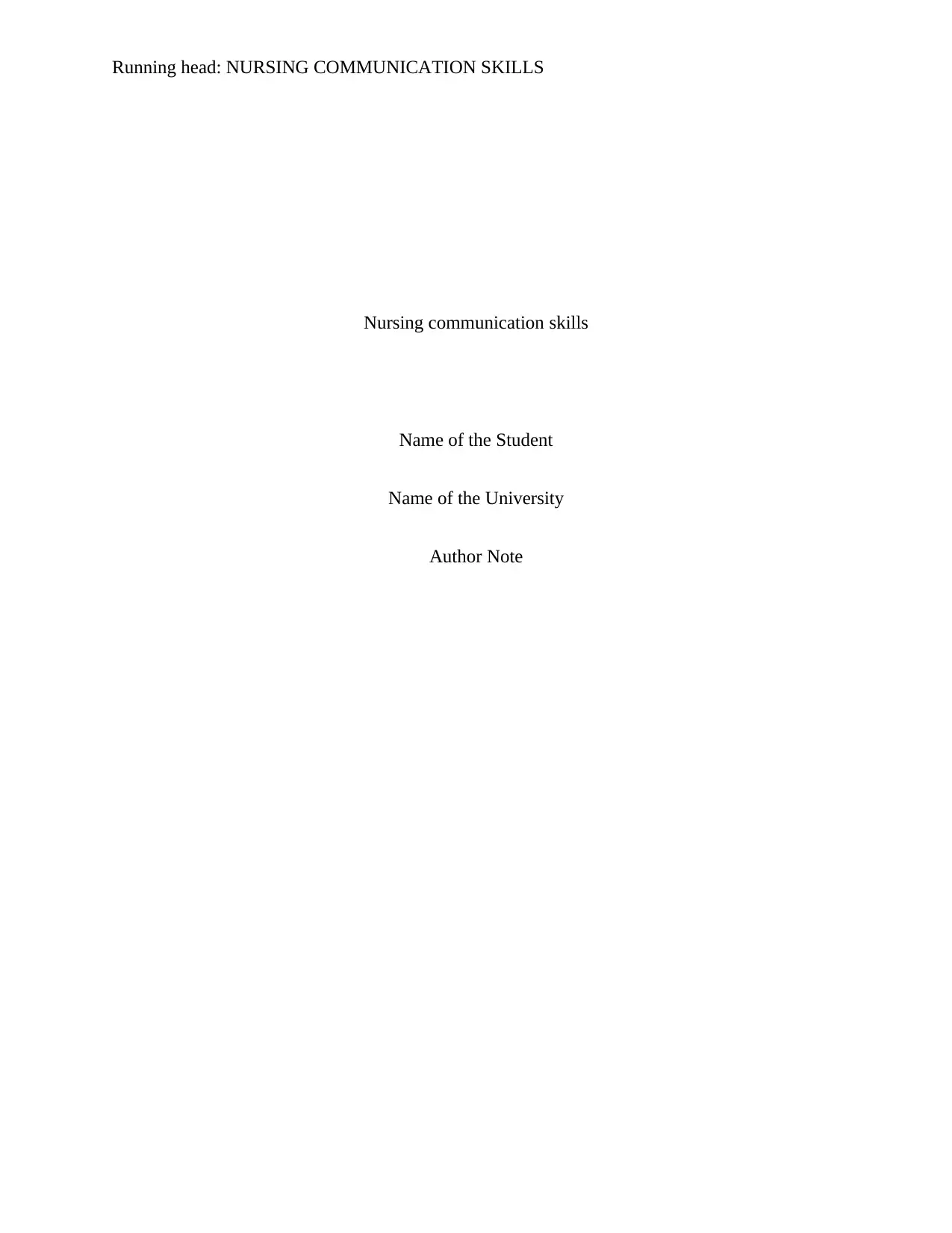
Running head: NURSING COMMUNICATION SKILLS
Nursing communication skills
Name of the Student
Name of the University
Author Note
Nursing communication skills
Name of the Student
Name of the University
Author Note
Paraphrase This Document
Need a fresh take? Get an instant paraphrase of this document with our AI Paraphraser

1NURSING COMMUNICATION SKILLS
Answer to question 1
Conducting interview (Silverman, Kurtz & Draper, 2016)-
Make interview preparation
Arrangement of chairs and tables
Maintain privacy to make information confidential
Enough time to be kept for interview
Beginning interview
Greetings in polite manner, formally and take patient’s name
Introduce to the interviewee, informing the background
Explain the purpose of the interview to maintain transparency and effective
communication
During interview
The nurse must maintain eye contact with interviewee
Present in warm manner to build rapport
Actively listen to patient – to identify and address concerns
End of the interview
Summarise the whole interview to the patient to ensure preparation for the next
day surgery
Inform the patient about the next step
Identify and ask questions if the patient has any worries
Answer to question 1
Conducting interview (Silverman, Kurtz & Draper, 2016)-
Make interview preparation
Arrangement of chairs and tables
Maintain privacy to make information confidential
Enough time to be kept for interview
Beginning interview
Greetings in polite manner, formally and take patient’s name
Introduce to the interviewee, informing the background
Explain the purpose of the interview to maintain transparency and effective
communication
During interview
The nurse must maintain eye contact with interviewee
Present in warm manner to build rapport
Actively listen to patient – to identify and address concerns
End of the interview
Summarise the whole interview to the patient to ensure preparation for the next
day surgery
Inform the patient about the next step
Identify and ask questions if the patient has any worries
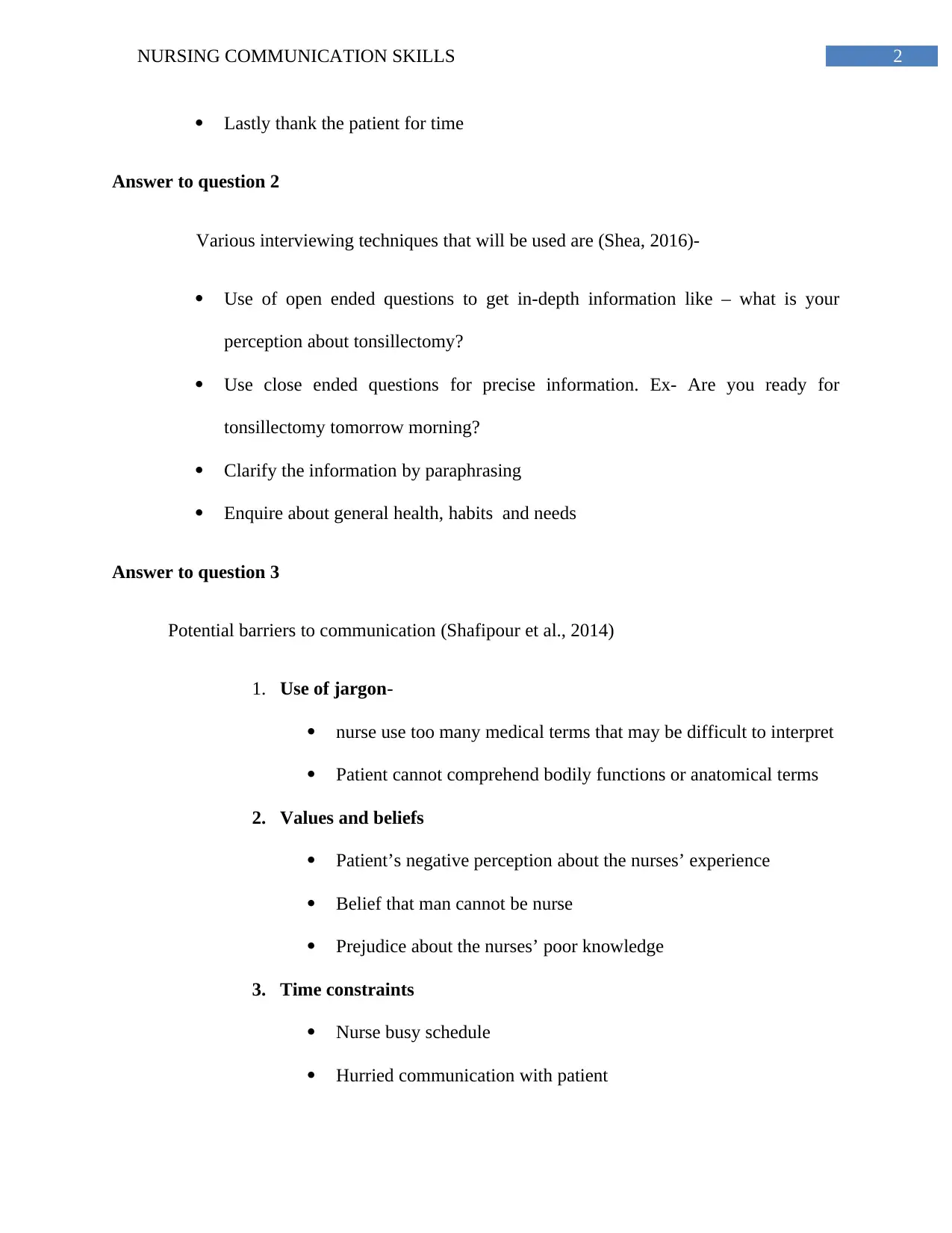
2NURSING COMMUNICATION SKILLS
Lastly thank the patient for time
Answer to question 2
Various interviewing techniques that will be used are (Shea, 2016)-
Use of open ended questions to get in-depth information like – what is your
perception about tonsillectomy?
Use close ended questions for precise information. Ex- Are you ready for
tonsillectomy tomorrow morning?
Clarify the information by paraphrasing
Enquire about general health, habits and needs
Answer to question 3
Potential barriers to communication (Shafipour et al., 2014)
1. Use of jargon-
nurse use too many medical terms that may be difficult to interpret
Patient cannot comprehend bodily functions or anatomical terms
2. Values and beliefs
Patient’s negative perception about the nurses’ experience
Belief that man cannot be nurse
Prejudice about the nurses’ poor knowledge
3. Time constraints
Nurse busy schedule
Hurried communication with patient
Lastly thank the patient for time
Answer to question 2
Various interviewing techniques that will be used are (Shea, 2016)-
Use of open ended questions to get in-depth information like – what is your
perception about tonsillectomy?
Use close ended questions for precise information. Ex- Are you ready for
tonsillectomy tomorrow morning?
Clarify the information by paraphrasing
Enquire about general health, habits and needs
Answer to question 3
Potential barriers to communication (Shafipour et al., 2014)
1. Use of jargon-
nurse use too many medical terms that may be difficult to interpret
Patient cannot comprehend bodily functions or anatomical terms
2. Values and beliefs
Patient’s negative perception about the nurses’ experience
Belief that man cannot be nurse
Prejudice about the nurses’ poor knowledge
3. Time constraints
Nurse busy schedule
Hurried communication with patient
⊘ This is a preview!⊘
Do you want full access?
Subscribe today to unlock all pages.

Trusted by 1+ million students worldwide

3NURSING COMMUNICATION SKILLS
Brief stating of pressing news
Patients feel neglected
4. Patient anxiety
Embarrassment to speak in front of nurse
Worry about post operative outcomes
5. Environmental factors- such as noise and privacy-
noise in background- impede communication
patient hearing problem may impede conversation
Patient sensitive to personal information, read or write
Need of translator
Withdraw information from nurse considering too private
6. Educational attainment
Patient/low educational attainment
Difficulty understanding care process
Nurse lacks effective verbal skills
Nurse lack interview technique
7. Patient perceptions-
patient may perceive a specific important as non-essential to be
discussed
over thinking about pain and fatigue after interview
8. professionalism
nurses including patient decision making
Acknowledgement of patient concerns
Brief stating of pressing news
Patients feel neglected
4. Patient anxiety
Embarrassment to speak in front of nurse
Worry about post operative outcomes
5. Environmental factors- such as noise and privacy-
noise in background- impede communication
patient hearing problem may impede conversation
Patient sensitive to personal information, read or write
Need of translator
Withdraw information from nurse considering too private
6. Educational attainment
Patient/low educational attainment
Difficulty understanding care process
Nurse lacks effective verbal skills
Nurse lack interview technique
7. Patient perceptions-
patient may perceive a specific important as non-essential to be
discussed
over thinking about pain and fatigue after interview
8. professionalism
nurses including patient decision making
Acknowledgement of patient concerns
Paraphrase This Document
Need a fresh take? Get an instant paraphrase of this document with our AI Paraphraser
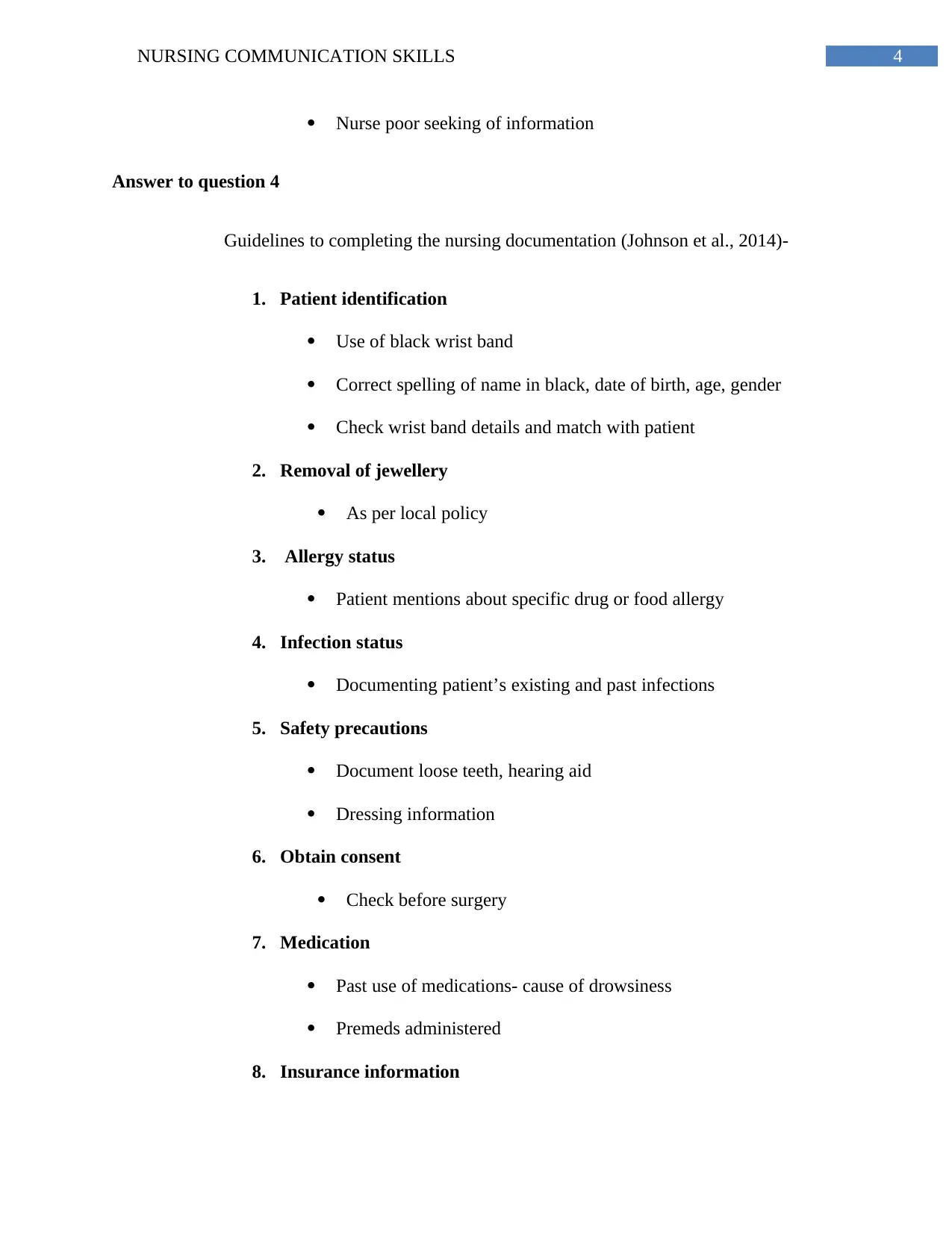
4NURSING COMMUNICATION SKILLS
Nurse poor seeking of information
Answer to question 4
Guidelines to completing the nursing documentation (Johnson et al., 2014)-
1. Patient identification
Use of black wrist band
Correct spelling of name in black, date of birth, age, gender
Check wrist band details and match with patient
2. Removal of jewellery
As per local policy
3. Allergy status
Patient mentions about specific drug or food allergy
4. Infection status
Documenting patient’s existing and past infections
5. Safety precautions
Document loose teeth, hearing aid
Dressing information
6. Obtain consent
Check before surgery
7. Medication
Past use of medications- cause of drowsiness
Premeds administered
8. Insurance information
Nurse poor seeking of information
Answer to question 4
Guidelines to completing the nursing documentation (Johnson et al., 2014)-
1. Patient identification
Use of black wrist band
Correct spelling of name in black, date of birth, age, gender
Check wrist band details and match with patient
2. Removal of jewellery
As per local policy
3. Allergy status
Patient mentions about specific drug or food allergy
4. Infection status
Documenting patient’s existing and past infections
5. Safety precautions
Document loose teeth, hearing aid
Dressing information
6. Obtain consent
Check before surgery
7. Medication
Past use of medications- cause of drowsiness
Premeds administered
8. Insurance information

5NURSING COMMUNICATION SKILLS
Insurance details documented
Information of Medicare/Medicaid coverage
9. Assessment of vitals
Abnormal readings reported
10. Site of surgery marked
Check by nurse
Check by day units preoperative checklist
Answer to question 5
Arrange for medical interpreter- to communicate fluently with patient
Effective use nonverbal skills- to avoid misunderstanding
Speak slowly- in shorter phrases to consider the best answer
Avoid Jargons, acronyms, idioms- to address patient queries and concerns
Provide written information- for better understanding (Meuter et al., 2015)
Answer to question 6
Interview preparation
Arrange for chairs
Schedule sufficient time
Maintain privacy
Beginning interview before patient arrives
Insurance details documented
Information of Medicare/Medicaid coverage
9. Assessment of vitals
Abnormal readings reported
10. Site of surgery marked
Check by nurse
Check by day units preoperative checklist
Answer to question 5
Arrange for medical interpreter- to communicate fluently with patient
Effective use nonverbal skills- to avoid misunderstanding
Speak slowly- in shorter phrases to consider the best answer
Avoid Jargons, acronyms, idioms- to address patient queries and concerns
Provide written information- for better understanding (Meuter et al., 2015)
Answer to question 6
Interview preparation
Arrange for chairs
Schedule sufficient time
Maintain privacy
Beginning interview before patient arrives
⊘ This is a preview!⊘
Do you want full access?
Subscribe today to unlock all pages.

Trusted by 1+ million students worldwide
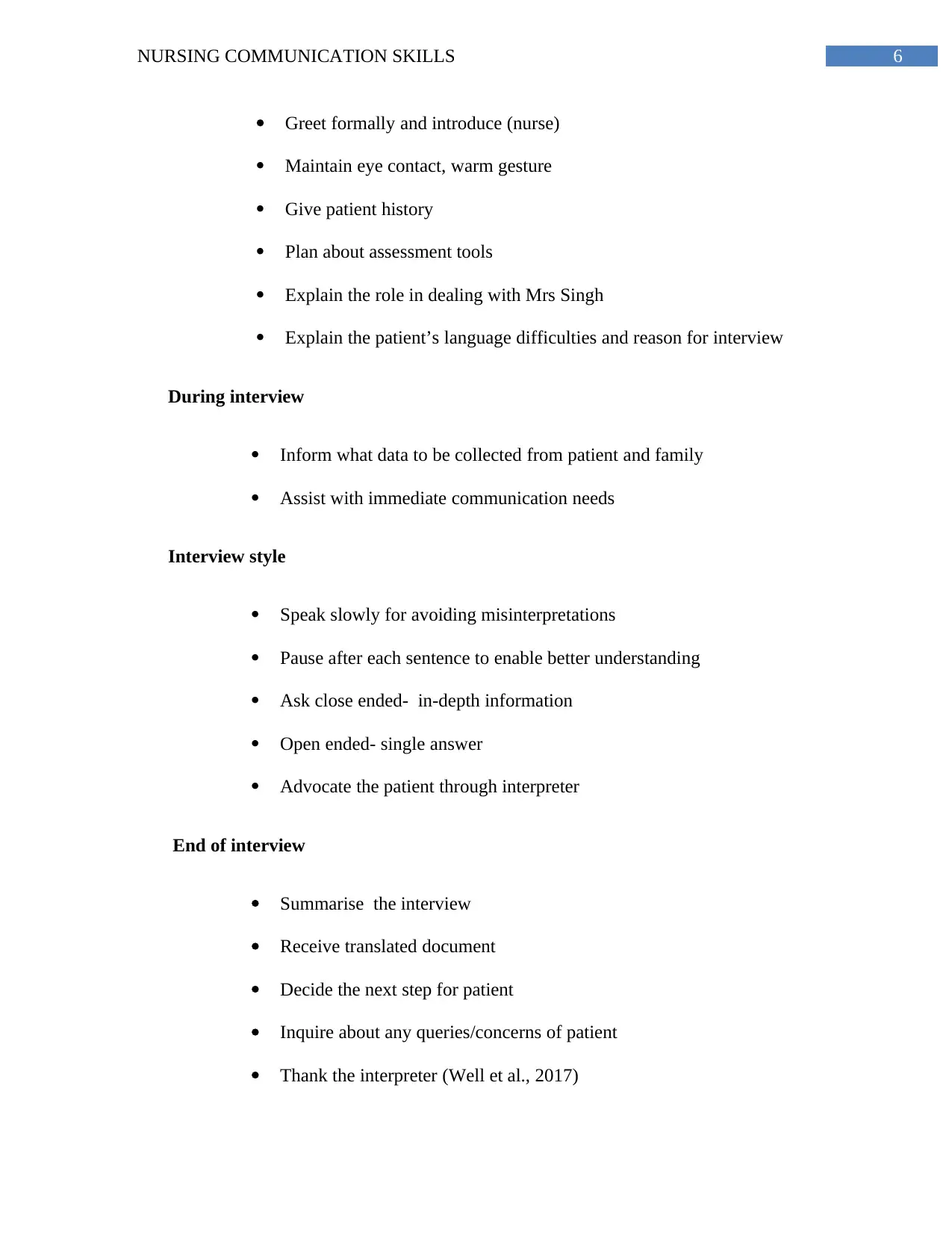
6NURSING COMMUNICATION SKILLS
Greet formally and introduce (nurse)
Maintain eye contact, warm gesture
Give patient history
Plan about assessment tools
Explain the role in dealing with Mrs Singh
Explain the patient’s language difficulties and reason for interview
During interview
Inform what data to be collected from patient and family
Assist with immediate communication needs
Interview style
Speak slowly for avoiding misinterpretations
Pause after each sentence to enable better understanding
Ask close ended- in-depth information
Open ended- single answer
Advocate the patient through interpreter
End of interview
Summarise the interview
Receive translated document
Decide the next step for patient
Inquire about any queries/concerns of patient
Thank the interpreter (Well et al., 2017)
Greet formally and introduce (nurse)
Maintain eye contact, warm gesture
Give patient history
Plan about assessment tools
Explain the role in dealing with Mrs Singh
Explain the patient’s language difficulties and reason for interview
During interview
Inform what data to be collected from patient and family
Assist with immediate communication needs
Interview style
Speak slowly for avoiding misinterpretations
Pause after each sentence to enable better understanding
Ask close ended- in-depth information
Open ended- single answer
Advocate the patient through interpreter
End of interview
Summarise the interview
Receive translated document
Decide the next step for patient
Inquire about any queries/concerns of patient
Thank the interpreter (Well et al., 2017)
Paraphrase This Document
Need a fresh take? Get an instant paraphrase of this document with our AI Paraphraser
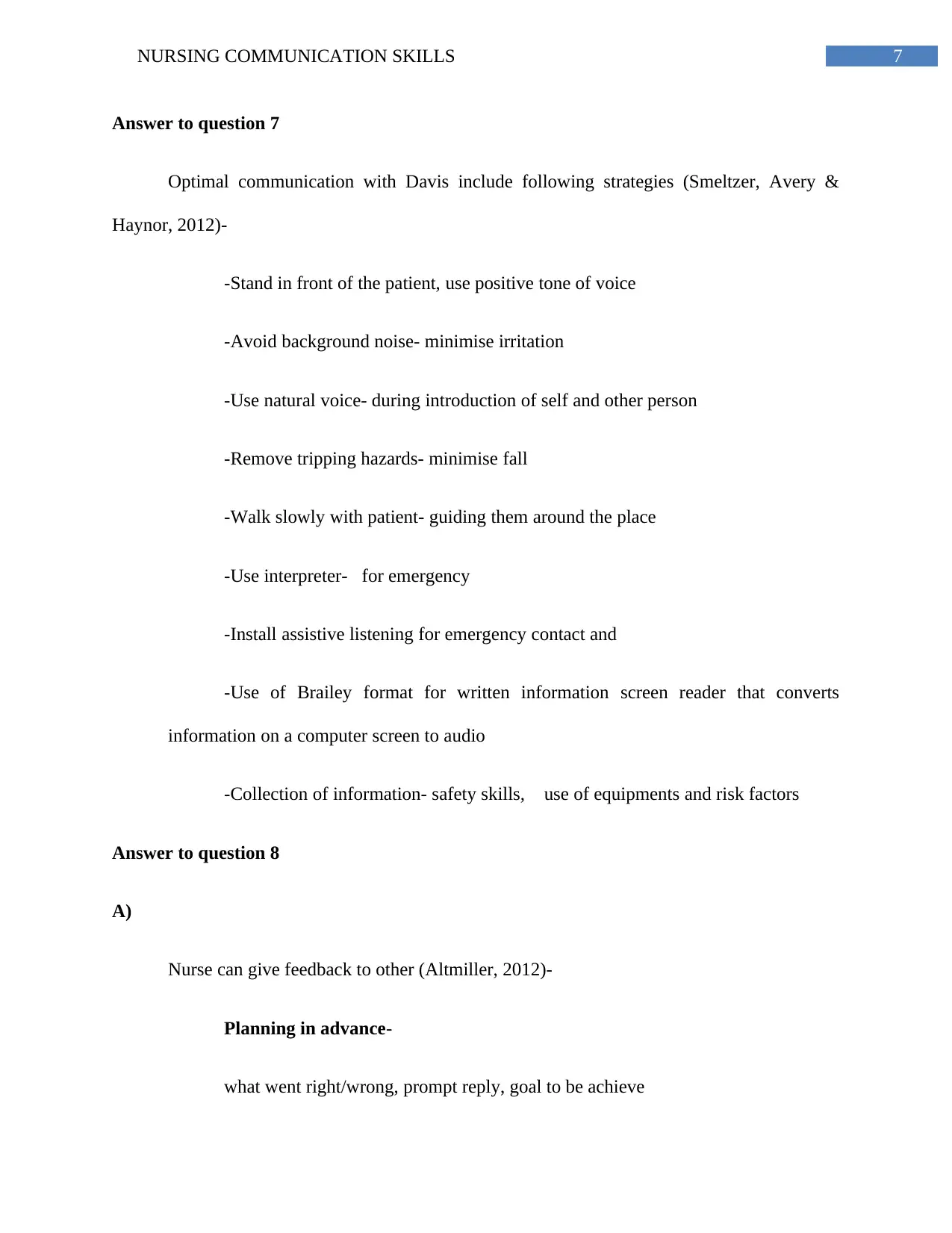
7NURSING COMMUNICATION SKILLS
Answer to question 7
Optimal communication with Davis include following strategies (Smeltzer, Avery &
Haynor, 2012)-
-Stand in front of the patient, use positive tone of voice
-Avoid background noise- minimise irritation
-Use natural voice- during introduction of self and other person
-Remove tripping hazards- minimise fall
-Walk slowly with patient- guiding them around the place
-Use interpreter- for emergency
-Install assistive listening for emergency contact and
-Use of Brailey format for written information screen reader that converts
information on a computer screen to audio
-Collection of information- safety skills, use of equipments and risk factors
Answer to question 8
A)
Nurse can give feedback to other (Altmiller, 2012)-
Planning in advance-
what went right/wrong, prompt reply, goal to be achieve
Answer to question 7
Optimal communication with Davis include following strategies (Smeltzer, Avery &
Haynor, 2012)-
-Stand in front of the patient, use positive tone of voice
-Avoid background noise- minimise irritation
-Use natural voice- during introduction of self and other person
-Remove tripping hazards- minimise fall
-Walk slowly with patient- guiding them around the place
-Use interpreter- for emergency
-Install assistive listening for emergency contact and
-Use of Brailey format for written information screen reader that converts
information on a computer screen to audio
-Collection of information- safety skills, use of equipments and risk factors
Answer to question 8
A)
Nurse can give feedback to other (Altmiller, 2012)-
Planning in advance-
what went right/wrong, prompt reply, goal to be achieve
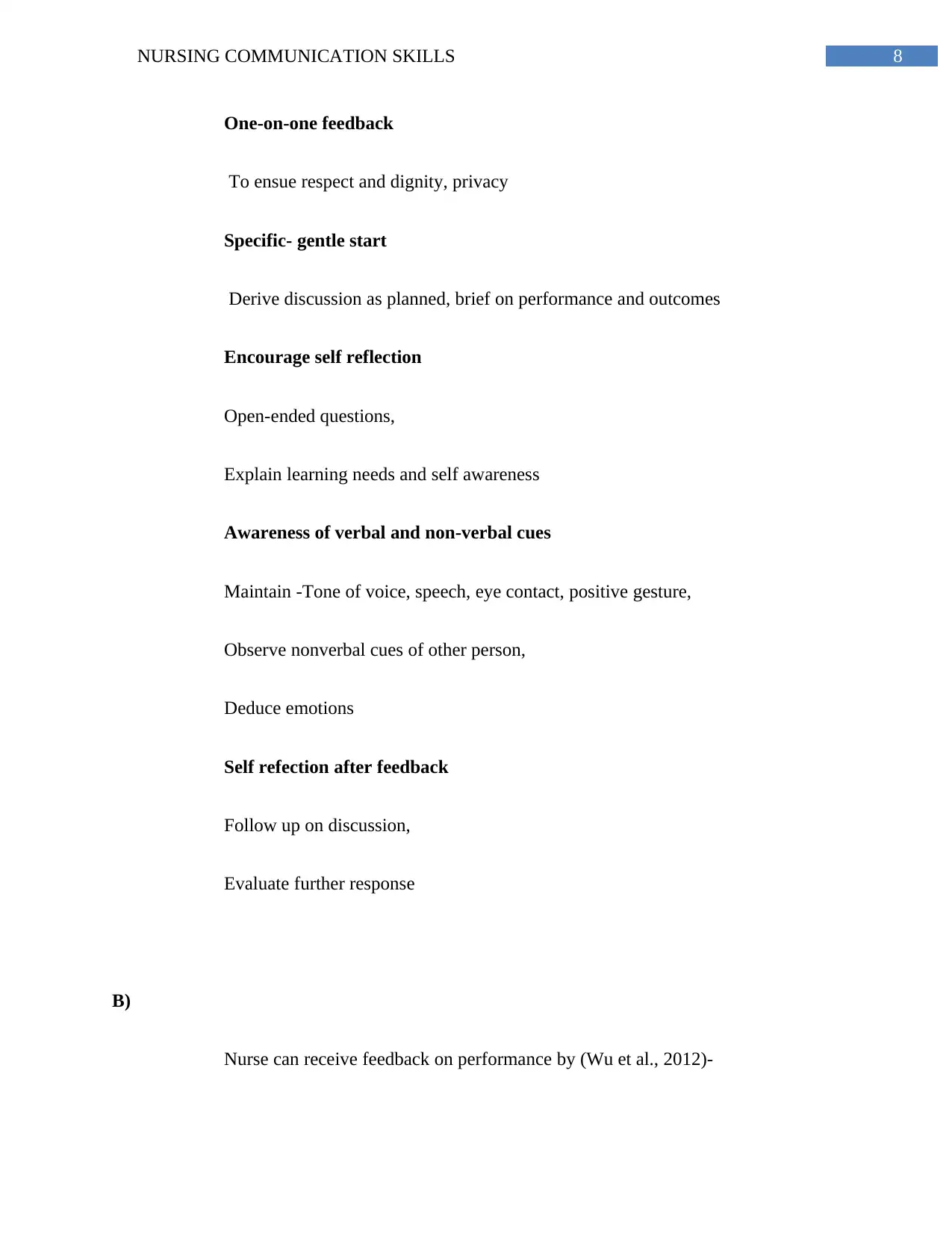
8NURSING COMMUNICATION SKILLS
One-on-one feedback
To ensue respect and dignity, privacy
Specific- gentle start
Derive discussion as planned, brief on performance and outcomes
Encourage self reflection
Open-ended questions,
Explain learning needs and self awareness
Awareness of verbal and non-verbal cues
Maintain -Tone of voice, speech, eye contact, positive gesture,
Observe nonverbal cues of other person,
Deduce emotions
Self refection after feedback
Follow up on discussion,
Evaluate further response
B)
Nurse can receive feedback on performance by (Wu et al., 2012)-
One-on-one feedback
To ensue respect and dignity, privacy
Specific- gentle start
Derive discussion as planned, brief on performance and outcomes
Encourage self reflection
Open-ended questions,
Explain learning needs and self awareness
Awareness of verbal and non-verbal cues
Maintain -Tone of voice, speech, eye contact, positive gesture,
Observe nonverbal cues of other person,
Deduce emotions
Self refection after feedback
Follow up on discussion,
Evaluate further response
B)
Nurse can receive feedback on performance by (Wu et al., 2012)-
⊘ This is a preview!⊘
Do you want full access?
Subscribe today to unlock all pages.

Trusted by 1+ million students worldwide
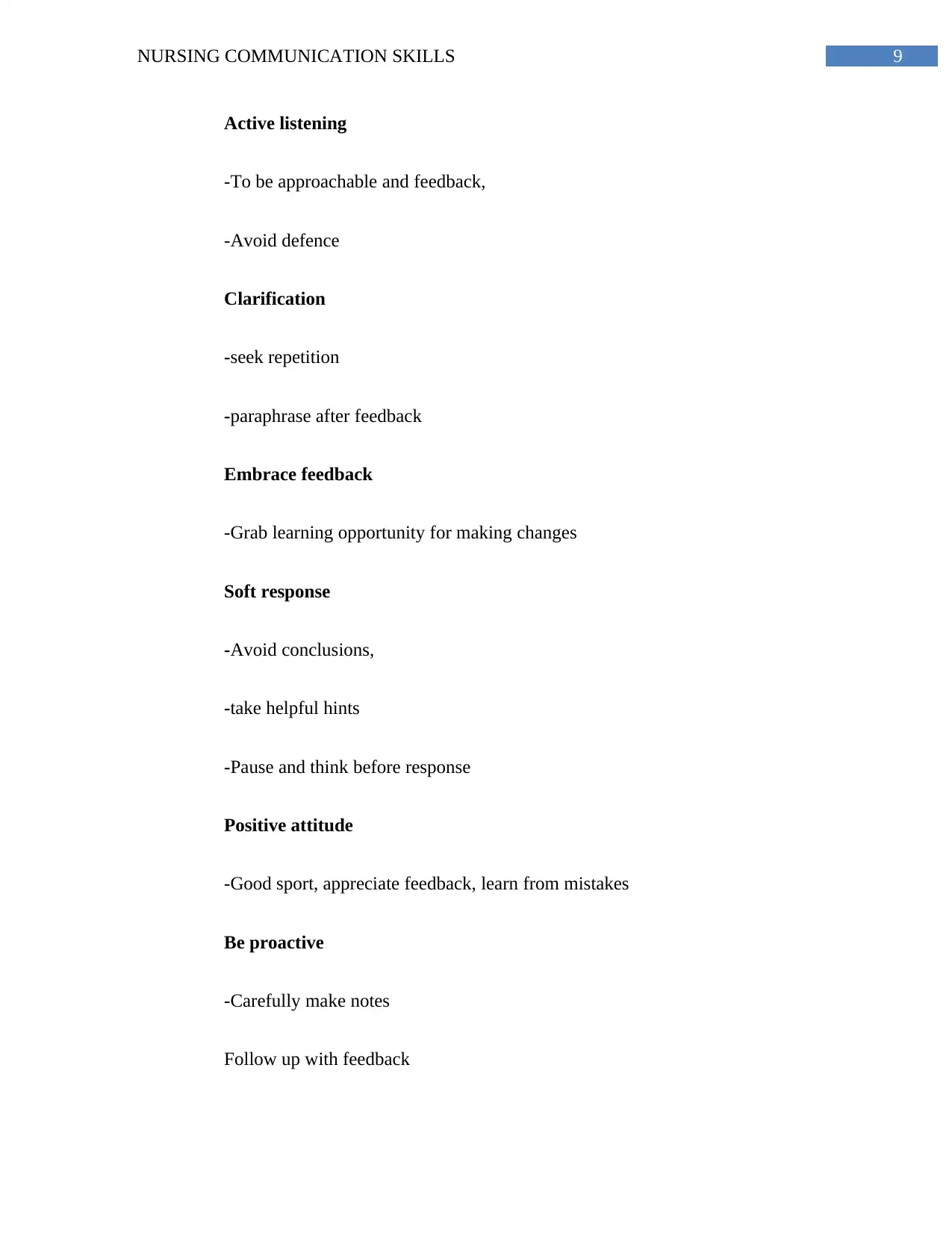
9NURSING COMMUNICATION SKILLS
Active listening
-To be approachable and feedback,
-Avoid defence
Clarification
-seek repetition
-paraphrase after feedback
Embrace feedback
-Grab learning opportunity for making changes
Soft response
-Avoid conclusions,
-take helpful hints
-Pause and think before response
Positive attitude
-Good sport, appreciate feedback, learn from mistakes
Be proactive
-Carefully make notes
Follow up with feedback
Active listening
-To be approachable and feedback,
-Avoid defence
Clarification
-seek repetition
-paraphrase after feedback
Embrace feedback
-Grab learning opportunity for making changes
Soft response
-Avoid conclusions,
-take helpful hints
-Pause and think before response
Positive attitude
-Good sport, appreciate feedback, learn from mistakes
Be proactive
-Carefully make notes
Follow up with feedback
Paraphrase This Document
Need a fresh take? Get an instant paraphrase of this document with our AI Paraphraser

10NURSING COMMUNICATION SKILLS
-share any information
Answer to question 9
Open discourse can be defined as open discussion with patient and family about harm to
the patient during health care process by certain incidents (Reisenhofer & Seibold, 2013).
Elements of the open disclosure are (Birks et al., 2014)-
Open and timely communication
-Open and honest communication about what went wrong
-Provide ongoing information
Acknowledgement
-Acknowledge carers/patients/families about adverse events
Apologizing and regret
-Apologise for harm caused by incident
-Express regret
Supporting the carer, family and patient needs
-Inform patient and family about adverse event facts
-Treat with respect, empathy and consideration
-Support as per needs
Support and meet the health care provider needs
-share any information
Answer to question 9
Open discourse can be defined as open discussion with patient and family about harm to
the patient during health care process by certain incidents (Reisenhofer & Seibold, 2013).
Elements of the open disclosure are (Birks et al., 2014)-
Open and timely communication
-Open and honest communication about what went wrong
-Provide ongoing information
Acknowledgement
-Acknowledge carers/patients/families about adverse events
Apologizing and regret
-Apologise for harm caused by incident
-Express regret
Supporting the carer, family and patient needs
-Inform patient and family about adverse event facts
-Treat with respect, empathy and consideration
-Support as per needs
Support and meet the health care provider needs
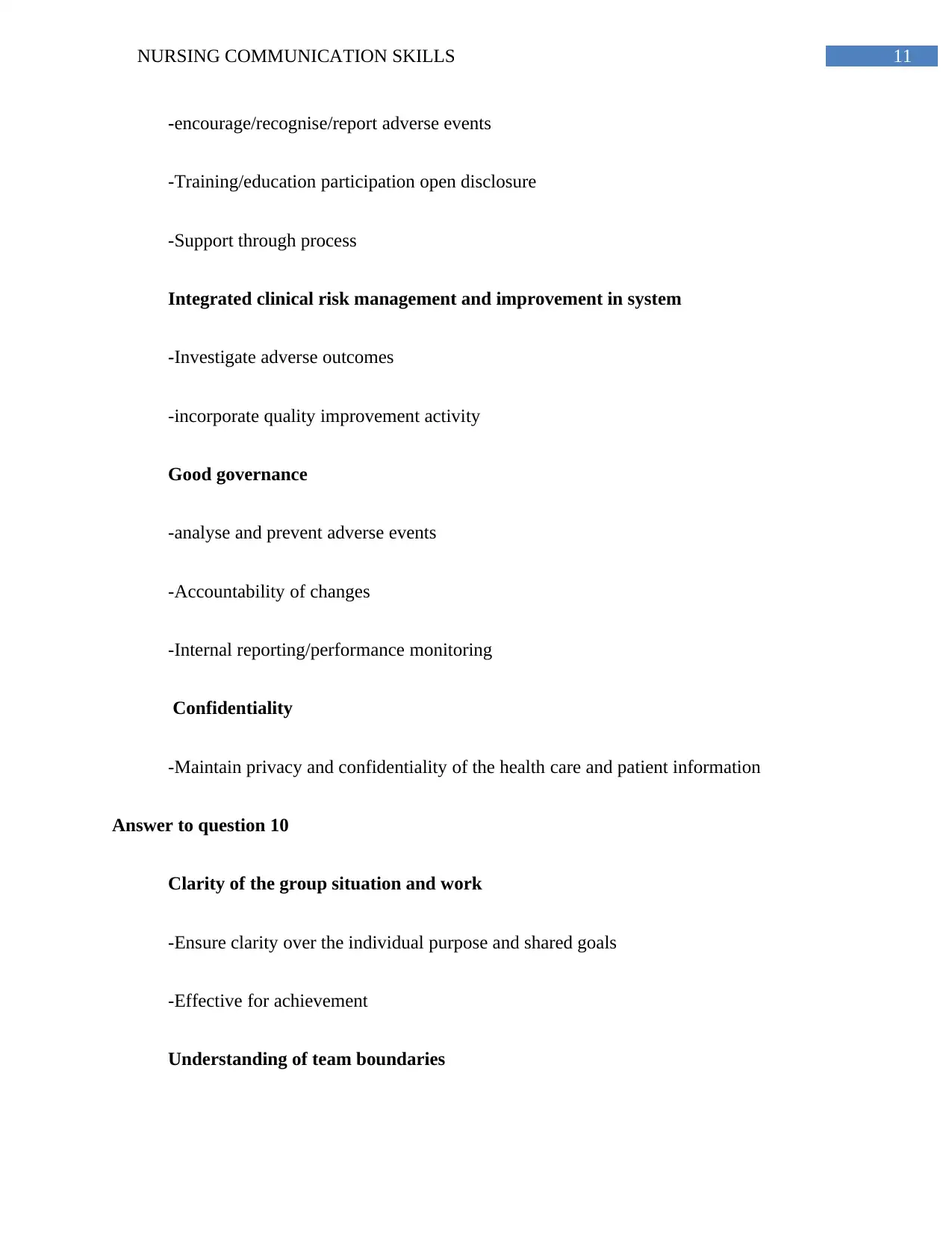
11NURSING COMMUNICATION SKILLS
-encourage/recognise/report adverse events
-Training/education participation open disclosure
-Support through process
Integrated clinical risk management and improvement in system
-Investigate adverse outcomes
-incorporate quality improvement activity
Good governance
-analyse and prevent adverse events
-Accountability of changes
-Internal reporting/performance monitoring
Confidentiality
-Maintain privacy and confidentiality of the health care and patient information
Answer to question 10
Clarity of the group situation and work
-Ensure clarity over the individual purpose and shared goals
-Effective for achievement
Understanding of team boundaries
-encourage/recognise/report adverse events
-Training/education participation open disclosure
-Support through process
Integrated clinical risk management and improvement in system
-Investigate adverse outcomes
-incorporate quality improvement activity
Good governance
-analyse and prevent adverse events
-Accountability of changes
-Internal reporting/performance monitoring
Confidentiality
-Maintain privacy and confidentiality of the health care and patient information
Answer to question 10
Clarity of the group situation and work
-Ensure clarity over the individual purpose and shared goals
-Effective for achievement
Understanding of team boundaries
⊘ This is a preview!⊘
Do you want full access?
Subscribe today to unlock all pages.

Trusted by 1+ million students worldwide
1 out of 19
Your All-in-One AI-Powered Toolkit for Academic Success.
+13062052269
info@desklib.com
Available 24*7 on WhatsApp / Email
![[object Object]](/_next/static/media/star-bottom.7253800d.svg)
Unlock your academic potential
Copyright © 2020–2025 A2Z Services. All Rights Reserved. Developed and managed by ZUCOL.


